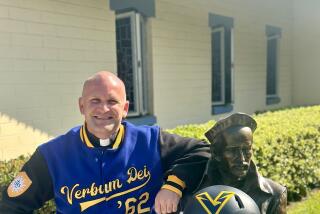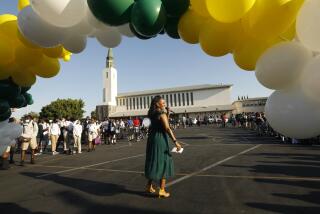Donors Keep Tuition-Free N.Y. Catholic School in Classical Shape
NEW YORK — The unusual story behind the founding of Regis High School is captured in the Latin words engraved in stone above the columns on its classical facade: Deo et Patriae Pietas Christiana Erexit.
Or, as even the most plodding of Latin scholars who ever trod the corridors of this renowned Jesuit high school might translate: Built by Christian piety for God and country.
Seventy-five years after a rich widow anonymously gave her pastor $500,000 to build a free school for Catholic boys, Regis is still giving full scholarships to every student it admits.
It draws the cream of the academic crop, mainly from parochial grammar schools in the five boroughs of New York, the surrounding three-state suburbs and sometimes even farther afield.
“Everyone thinks I’m crazy to come into the city,” said Mark Mazzetti, 14, a freshman who spends three hours a day traveling back and forth from Princeton, N.J.
Starts Day Early
“My friends back home think I live here,” said Marty Cassidy, 14, a freshman who rises at 5:30 a.m. to commute with his brother, a sophomore, from New Canaan, Conn.
“The journey can take up to two hours each way, but I don’t have any regrets. You can do a lot of homework on the train--or you can just sleep.”
For Luis Taveras, 17, a senior who chose Regis over the Bronx High School of Science, the trip to school is a 30-minute subway ride from the Bronx.
“I love it here,” Taveras said. “When you come from the Bronx, it’s really challenging to grow up in a different kind of world. This school is a meeting ground for people from so many different backgrounds.”
Today’s 501 Regis students are getting their free education--valued by school officials at over $24,000--thanks not only to the generosity of the original benefactor and her family who over the years gave millions to keep the school running, but its 7,500 alumni who in recent years have become major benefactors in their own right.
$3.3-Million Budget
About half the $3.3-million budget comes from interest on the school’s investments. The rest is raised each year from alumni, foundations and other sources.
“Each year the costs go up at least $200,000,” said Father James J. Fischer, the president since 1980. “That’s not going to end.’
But while other Catholic schools struggle with rising tuitions and contracting enrollments, Regis has been able to pour $5 million in recent years into expanding science labs and other major renovations of its building on East 84th St., two blocks from Central Park. The top faculty salaries will be near $40,000 this fall.
Last year’s seniors scored an average of 1,273 on the Scholastic Aptitude Test, 369 points above the national average. Many graduates attend select colleges, including 84 who went on to Ivy League colleges in the past four years alone.
More than a third of the students come from families with incomes below $30,000 a year, and 40% are the children of immigrants from Ireland, Puerto Rico, China, the Philippines, Italy, Cuba, Haiti and three dozen other countries.
‘An Immigrants’ School’
“It’s still very much an immigrants’ school,” said Father Vincent W. Hevern, the school psychologist.
The school, largely white for decades, now has a 28% minority enrollment, including 60 Latino students (12%), 51 Asian (10%) and 28 black (6%). Unlike many parochial schools, especially in big cities, it does not admit non-Catholics.
Each fall, on the first Saturday in November, about 900 students take a standardized admissions test. Students also are judged on their elementary school grades, activities and, for the finalists, an interview. The 130 scholarship winners are chosen shortly before Christmas.
In 1978 nearly 1,300 students took the entrance test. The number fell to a low of 770 in 1987 before rebounding. Most of those admitted score in the top 5% on standardized tests--a common cutoff for the gifted.
May Admit Girls
Regis officials, casting a worried eye on the dwindling pool of candidates, talk openly of the possibility of admitting girls some day, as all Jesuit colleges and some 10 Jesuit high schools already have done.
“There’s no comparable opportunity for Catholic girls in the city of New York,” said Father Frederick J. O’Brien, the headmaster. “If the demographics ever became really horrendous, that’s one way to broaden the pool.”
O’Brien will be succeeded as headmaster this summer by Father James F. Kuntz, who has been headmaster of St. Peter’s Prep in Jersey City, New Jersey. Kuntz, a 1966 Regis graduate, will be only the second alumnus ever to run the school.
Fischer said he doesn’t think Regis’ boys-only status could withstand a legal challenge. “I think someone would crack that tomorrow, and we’d have to take in girls if they got a good lawyer.”
The school’s two top administrators are two of only a dozen Jesuits left on the 50-member staff. A quarter-century ago, more than half the faculty were Jesuit priests or “scholastics”--young Jesuits halfway through the 13-year preparation process leading to ordination. Not a few of them were alumni. In fact, a Regis yearbook marking the 50th anniversary in 1964 noted that almost 10% of its alumni were priests.
No Replacements
But few Regians opt for the priesthood these days. Many of the Jesuits on the faculty are nearing retirement, and their replacements are not in sight. It has only one scholastic this semester “and we’re not sure we’ll get a replacement when he leaves,” said Frank Walsh, the assistant headmaster.
Other things have changed at the school. There was a time, said Lynda Blakinship, chairman of the science department, when a Regis student was just a student. “Now he’s taking care of the younger brothers and sisters, cooking the meals, doing the wash while the mother works. In my advanced placement physics class, two-thirds of the guys had jobs.”
No longer are students flunked out in droves in the sort of educational triage that once characterized many Jesuit schools.
Latin, long the backbone of the curriculum, became optional four years ago.
No Reason for Latin
While that raised the hackles of some alumni, O’Brien said, “we’re trying to get needy students in here. We’re bringing in kids who very often are the first people in their family to complete high school. They know no reason to study Latin.”
While it is no longer producing legions of priests, Regis does inculcate in its students the value of community service.
Seniors are required to spend Tuesday mornings out as volunteer tutors in grammar schools in disadvantaged neighborhoods, or working in hospitals or nursing homes. Most seniors are freed from all classes during the last trimester to devote full time to such pursuits, or to work on job internships.
Its alumni include several university presidents, including Timothy S. Healy (1942) of Georgetown and Joseph A. O’Hare (1948) of Fordham, as well as banking executives, corporate chieftains and judges--although rival Xavier High School boasts Supreme Court Justice Antonin Scalia.
Thick With Lawyers
The alumni rolls are also thick with lawyers who first honed their oratorical skills in the classrooms of Regis and its Hearn Society, a perennial state debating champion.
“We still produce more lawyers than anything else,” O’Brien said. “If you teach here for a while you understand that it is not an accident. Our kids love to argue.”
But the school’s best-known graduate is Dr. Anthony S. Fauci, the AIDS researcher and director of the National Institute of Allergy and Infectious Diseases whom President Bush has called one of his personal heroes.
Fauci, a 1958 graduate, remembers fondly his four years commuting as a straphanger from Brooklyn to the upper East Side, where he encountered “an academic excellence that really was unmatched in all of the educational experiences I’ve had since then.”
Will Retain Character
Regis is now run by a board that includes both lay and Jesuit members. Its leaders say it will retain that Jesuit character, even as the numbers of priests on its staff dwindle.
More to Read
Sign up for Essential California
The most important California stories and recommendations in your inbox every morning.
You may occasionally receive promotional content from the Los Angeles Times.









